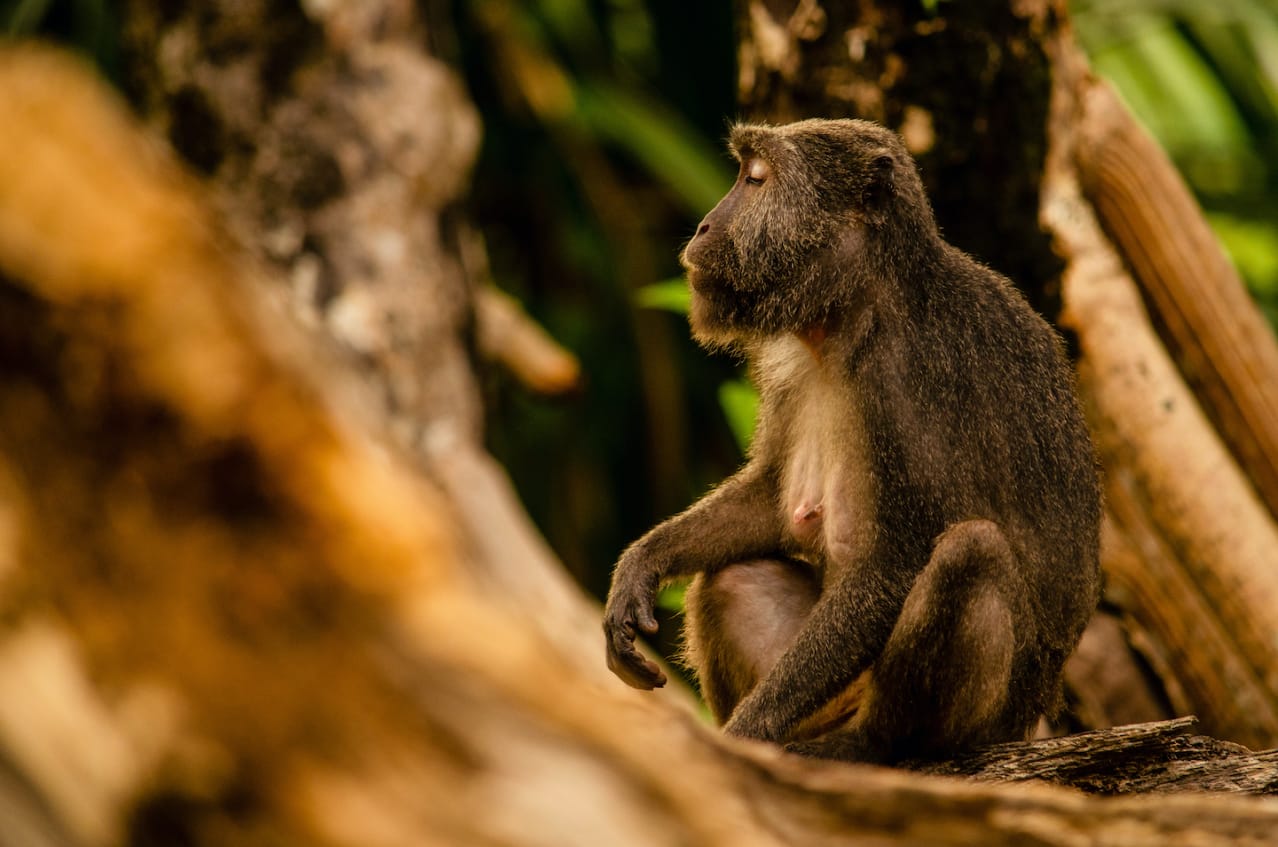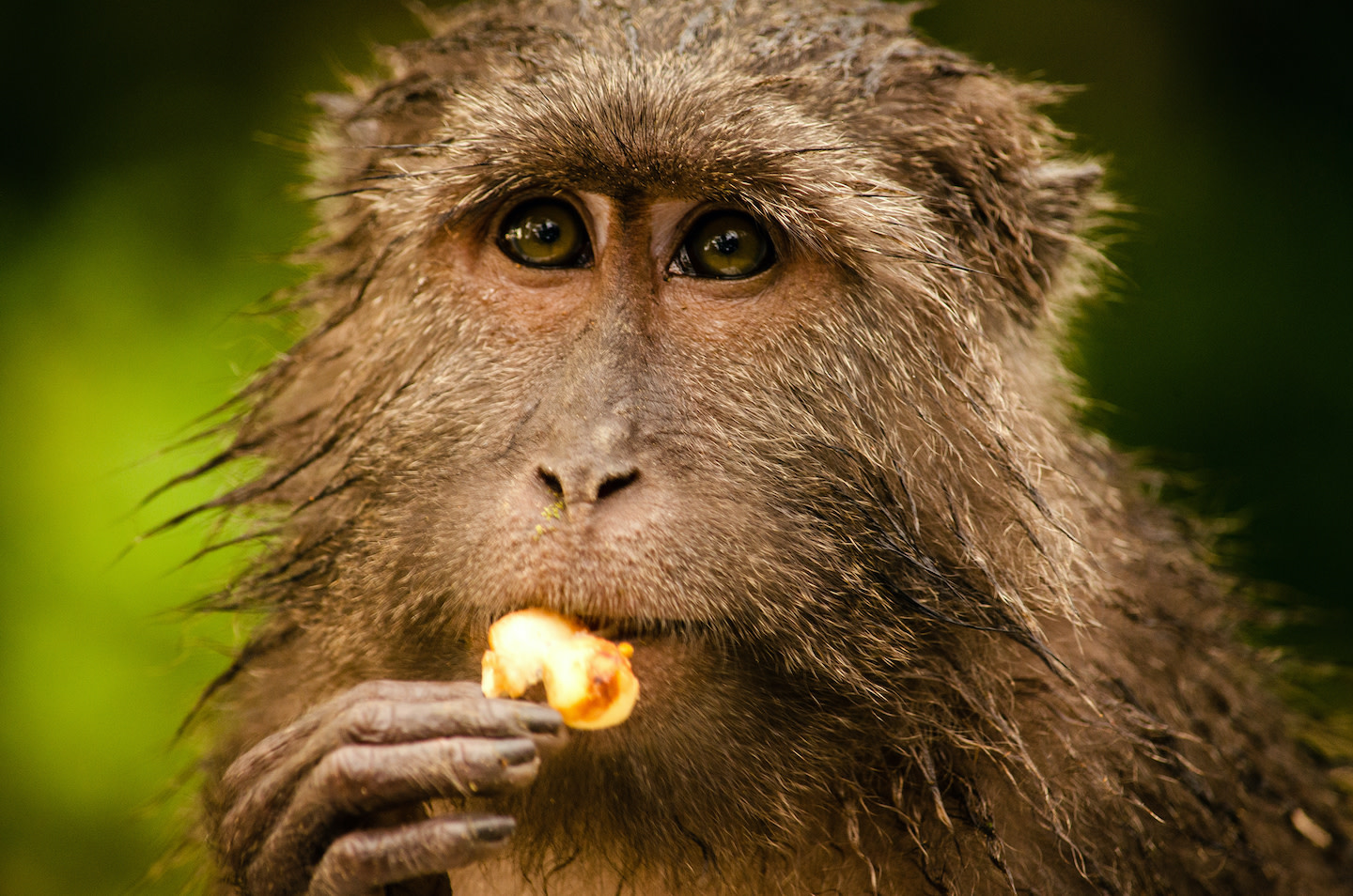 Listen to this article
•
15:34 min
Listen to this article
•
15:34 min
On a sweltering summer day, I was tracking the afternoon sun with a troop of monkeys. I was working on Great Nicobar Island, the southernmost of the Andaman and Nicobar islands. These biogeographic wonders in the Andaman Sea hold within their narrow boundaries diverse habitats and life, including the enigmatic Nicobar long-tailed macaque (Macaca fascicularis umbrosa) that I was studying on that hot day. These stout, grey primates had been up since the crack of dawn, grooming one another and searching for food. After an active morning of feeding on the endemic screw pine (Pandanus fascicularis), the macaques had steadily wandered into the neighbouring village’s coconut and areca nut farms for seconds. Quietly and strategically navigating farms as unwelcome visitors is mentally and physically draining, and by mid-afternoon, the monkeys were ready to snooze, away from the sun and people’s eyes. Tailing them through their exploits, I found myself crouching low in the undergrowth of an abandoned, overgrown garden. The monkeys and I were thankful for the shade, but not for the sand flies feasting on us in the dense vegetation.

Cover photo: Nicobar long-tailed macaques are curious, adaptable creatures, eager to learn about their surroundings. Here, a male named Beej takes a long look at the author, before his afternoon siesta. Cover Photo: Ishika Ramakrishna
Sitting there in a hidden thicket, with them resting by my side, I couldn’t help but fall in love with the species all over again. One of the individuals in my troop, Beej, was lazing on his back right in front of me. His lanky arm meticulously itched his entire face, while he swatted some flies with his foot. Another male, Tripod, was busy nursing a fresh wound from a fight. He licked his fingers and then swabbed the hurt area with unwavering focus. A female, Shadow, was nursing her infant a couple of feet away, grooming him carefully while trying to stay awake. A sub-adult female, called Cheese, burst into a series of hiccoughs while grooming the alpha male of the troop. In the low canopy right overhead, some juvenile macaques were swinging violently, chasing one another, dropping showers of dry leaves into my lap. As each of them went about their own affairs, they sounded low “cooo” calls to one another, maintaining contact and communication.
Social species
These macaques look markedly different from the more common bonnet and rhesus macaques of mainland India. They are larger, with broader faces and deep-set, expressive eyes. Their long tails help them balance on flimsy trees along the coast, risky business in the strong sea breeze. They have wiry fur that has a brown tint in the hot sun. In round-the-year humid weather with frequent showers, their coats allow them to venture out without getting soaked or cold. Their bodies, behaviour, and diet are perfectly suited to the tropical islands where they are found. Apart from Great Nicobar, they are also found on the islands of Katchal and Little Nicobar. Across all three islands, they are known to survive in a range of habitat types — mangrove forests, dense rainforests, coastal stretches, and more recently, human settlements.

The Nicobar long-tailed macaque, like many other nonhuman primates, is an adaptable, intelligent, and highly social species. Troops are of varying sizes depending on the food available around them, and each troop defends its territory staunchly. Trespassing by a neighbouring troop can result in aggression and fights. Within a troop, playing, grooming, and group foraging helps strengthen social bonds and communication cues, which aid them during inter-troop rivalries. After all, delicious fruit from Pandanus, Ficus and Artocarpous trees are treasures worth fighting for.
Savvy survivors
These primates are part of the larger group of long-tailed macaques found across Southeast Asia — in Thailand, Singapore, Malaysia, Philippines, and Indonesia. Several macaques from these countries have been known to use tools, representative of higher intellect, creativity, and problem-solving capabilities. Some groups who live close to tourist sites in Bali have begun swiping personal items from distracted people (like sunglasses, cameras, or hats) in the hope that they will be given some food in exchange for those belongings. The Indian cousins of these clever monkeys are just as nifty at making the most of their immediate surroundings.

The Nicobar macaques are known to use a range of tools for purposes like flossing their teeth (with leaf fibres), itching (with twigs or sticks), playing (with sticks or other objects, like cloth), finding and preparing food (using a hard rock to pound coconuts open), and perhaps even for communication (using objects to threaten another individual). They’ve also been observed to alter their behaviour to incorporate new foraging tactics in villages and small towns. For example, instead of feeding on a wild fruiting tree in their full strength, a troop of macaques may split up into a small groups of individuals so as to feed on foods like coconut, jackfruit, papaya and mango in a village garden to avoid attracting attention. The macaques may even venture into farms during a heavy downpour, as people cannot guard their crops in the rain.
While we knew little about this fascinating species until a decade into the 21st century, primatologists across the country have taken a keen interest in them at the end of the 2010s. Thanks to this, we now know more about their population sizes, where they’re found, and their many interesting behaviours. We’ve learned about the threats they face and the steps we need to take towards ensuring their conservation in the future. In 2004, the tsunami that took most of Asia by surprise also shook the long-tailed macaques. Troops that lived along coastlines lost their habitat, food trees, and several individuals — especially the younger ones. Since that fateful day, they have gradually recovered along with the people of the islands, who have rebuilt their lives from scratch.

Conservation needs
These islands can be unmoving and dynamic at the same time. Life moves slowly in these places, and the macaques are accustomed to that pace of life. Sudden changes in climate or natural disasters can alter their lives and safety — after all it is an island with not much room for escape. So far, the main threats that these primates have faced are habitat losses due to local developmental activities and calamity, attacks from domestic dogs trained to guard farmlands, and occasional hunting by indigenous and settler communities in retaliation for crop losses to the macaques. However, more significant threats are currently looming on the horizon for this small population of endemic primates.
The Andaman and Nicobar Islands’ intrinsic exotic nature has earned it a spotlight in ongoing discussions to accelerate tourism ventures. These development ideas are not new, but the renewed impetus for them has resulted in overlooking the ecological consequences of these projects, unlike before. Islands like Great Nicobar which hold important biodiversity like the long-tailed macaque, Nicobar tree shrew, and Nicobar megapode are fragile and vulnerable. People’s livelihoods and cultures are linked closely to the forests and the sea that surrounds them. Any development needs to be sensitive to the potential impact it may have on the islands’ people and wildlife.

Long-tailed macaques found in Asia are not vulnerable or endangered according to the IUCN, but their Nicobar subspecies are of immense biological importance and require closer attention. We have only scraped the surface of all there is to learn about this unique species. Indeed most of their wonders are yet to be unearthed and their conservation requires in-depth knowledge about their behaviour and ecology. We must take them into consideration before clearing important habitats and pushing them further into human settlements. It is important to remember that just because these macaques have the potential to adjust and adapt to changing environments, doesn’t mean they should.






